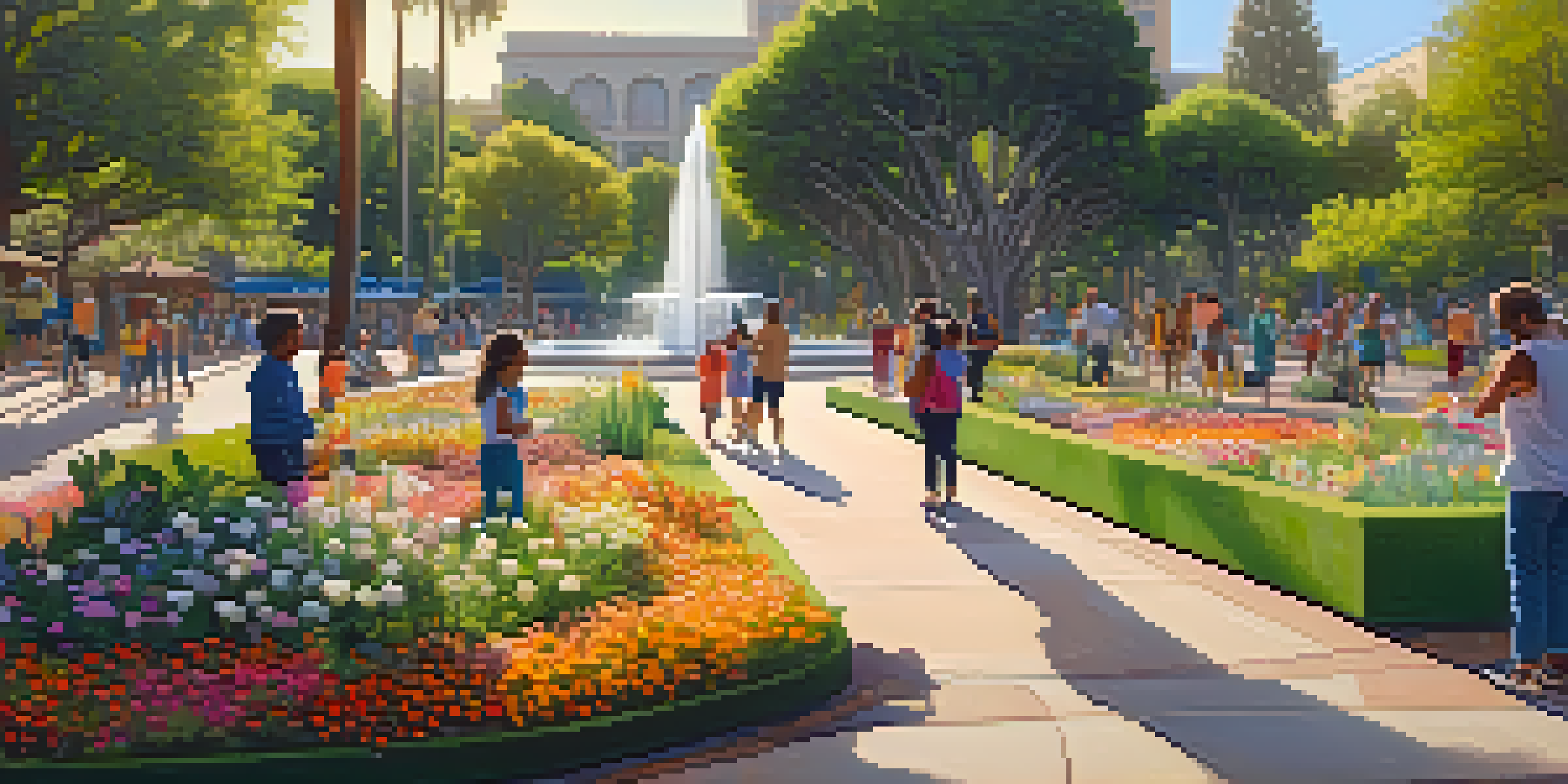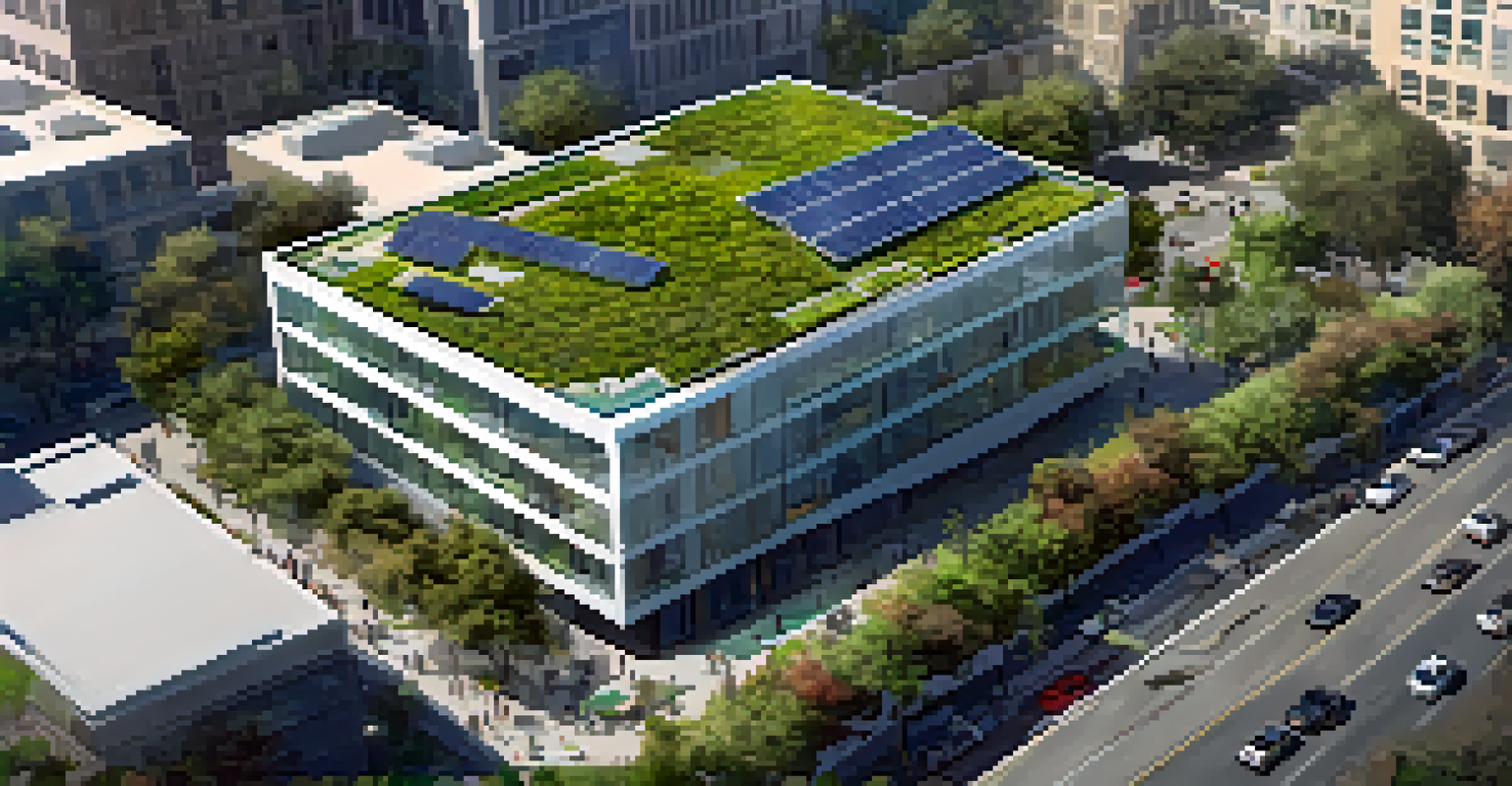Innovations in Urban Design: Lessons from Los Angeles

Transforming Public Spaces for Community Engagement
Los Angeles has reimagined its public spaces to foster community interaction. Parks and plazas have been redesigned not just for aesthetics but also for functionality, encouraging people to gather and engage. For instance, the transformation of Pershing Square into a vibrant hub showcases how thoughtful design can enhance social cohesion.
The public space is a canvas for the community, a reflection of its spirit and aspirations.
By integrating art installations and hosting community events, these spaces become more than just passive areas—they invite participation. This approach highlights the importance of creating environments that cater to the needs of diverse users, from families to artists. The success of such projects demonstrates that public spaces can act as the heart of urban life.
Moreover, these innovations have inspired other cities to rethink their own public spaces, recognizing the potential for societal impact. As urban designers continue to prioritize community engagement, lessons from Los Angeles will undoubtedly shape future projects worldwide.
Sustainable Design: Lessons from LA's Green Initiatives
Sustainability is a central theme in Los Angeles' recent urban design efforts. The city has embraced green architecture, incorporating eco-friendly materials and renewable energy sources into new buildings. For example, the Los Angeles County Museum of Art (LACMA) expansion has emphasized green roofs and energy-efficient systems, showcasing a commitment to environmental stewardship.

These sustainable practices not only reduce the carbon footprint but also promote a healthier lifestyle for residents. By integrating nature into urban environments—think green walls and urban gardens—Los Angeles is setting a precedent for how cities can harmonize with their natural surroundings. This focus on sustainability encourages other urban areas to adopt similar principles.
Community Spaces Foster Engagement
Los Angeles is transforming public spaces to encourage community interaction and social cohesion.
Furthermore, the city's push for better public transportation options—like the expansion of the metro system—highlights the importance of reducing reliance on cars. As urban planners observe LA's progress, they can glean insights into implementing their own sustainable initiatives.
Smart Technology: Integrating Innovation into Urban Living
Los Angeles is at the forefront of integrating smart technology into urban design, enhancing the quality of life for its residents. From smart traffic signals that optimize flow to apps that provide real-time transit information, technology is playing a crucial role in improving urban infrastructure. These innovations not only make city navigation easier but also contribute to overall efficiency.
Design is not just what it looks like and feels like. Design is how it works.
For instance, the use of sensors in public spaces helps monitor air quality and crowd density, allowing city officials to make informed decisions. This data-driven approach enables a more responsive urban environment, ensuring that city resources are allocated where they’re needed most. By adopting these smart technologies, LA is paving the way for a more connected urban experience.
As cities worldwide face similar challenges, the lessons learned from LA's integration of technology can serve as a roadmap for effective urban planning. The emphasis on innovation showcases a commitment to creating smarter, more livable cities.
Inclusive Urban Design: Prioritizing Accessibility
Inclusivity is a vital aspect of urban design, and Los Angeles is striving to ensure that all residents can access its spaces. The city has implemented various initiatives aimed at making public transit and community areas more accessible for people with disabilities. This focus on inclusivity recognizes that a city thrives when everyone can participate in its offerings.
For example, recent improvements to sidewalks and transit stations have included features like curb cuts and auditory signals, making navigation easier for those with mobility challenges. By prioritizing accessibility, Los Angeles sets a standard for other cities, illustrating that good design benefits all community members.
Sustainability Drives Urban Design
The city is prioritizing eco-friendly practices and green architecture to promote a healthier urban environment.
Furthermore, engaging with local communities to understand their needs highlights the role of participatory design. As urban planners continue to prioritize inclusivity, the benefits will ripple out, fostering a sense of belonging and community pride.
Revitalizing Neighborhoods through Urban Design
Urban design in Los Angeles has played a critical role in revitalizing neighborhoods that were once overlooked. Through targeted investments and creative design strategies, areas like the Arts District have transformed into thriving cultural hubs. This revitalization demonstrates how thoughtful urban planning can breathe new life into communities.
The incorporation of mixed-use developments, with retail, housing, and entertainment options in close proximity, encourages foot traffic and fosters local economies. By creating vibrant neighborhoods where people want to live, work, and play, LA is setting an example for urban regeneration efforts elsewhere.
Moreover, revitalization efforts often include preserving historical elements, ensuring that the character of neighborhoods is maintained. As other cities face similar challenges, the lessons learned from LA’s revitalization strategies will be invaluable.
Transportation Innovations: Rethinking Mobility in LA
Transportation is a critical component of urban design, and Los Angeles is actively rethinking how its residents move around the city. With traffic congestion a well-known issue, the city has invested in expanding its public transit options, including the metro and bus systems. This shift encourages more people to opt for public transport over personal vehicles, reducing traffic and emissions.
The introduction of bike lanes and pedestrian-friendly streets has also made it easier for residents to navigate the city without relying on cars. By creating a more walkable environment, Los Angeles is fostering a culture that values healthy, sustainable modes of transportation. These changes reflect a growing recognition of the importance of mobility in urban planning.
Art Enriches Urban Identity
Integrating public art into urban design reflects Los Angeles' diverse culture and enhances community pride.
As other cities grapple with similar transportation challenges, Los Angeles offers a blueprint for how to develop a more integrated and efficient transport system. The innovations made here could very well influence the future of urban mobility.
Cultural Expression: Integrating Art into Urban Design
Art has always been a vital part of Los Angeles' identity, and its integration into urban design is a testament to this cultural richness. Public art installations, murals, and sculptures are woven into the fabric of the city, making art accessible to everyone. This approach not only enlivens public spaces but also reflects the diverse stories and communities that make up LA.
For instance, the LA Mural Conservancy works to preserve the city's vibrant mural culture, ensuring that artistic expression remains a core component of urban life. These efforts foster a sense of pride and ownership among residents, encouraging them to engage with their surroundings.

As other cities look to enhance their cultural landscapes, the lessons learned from Los Angeles' commitment to art in urban design serve as an inspiring example. By viewing art as a critical element of urban planning, cities can create more engaging and meaningful environments.